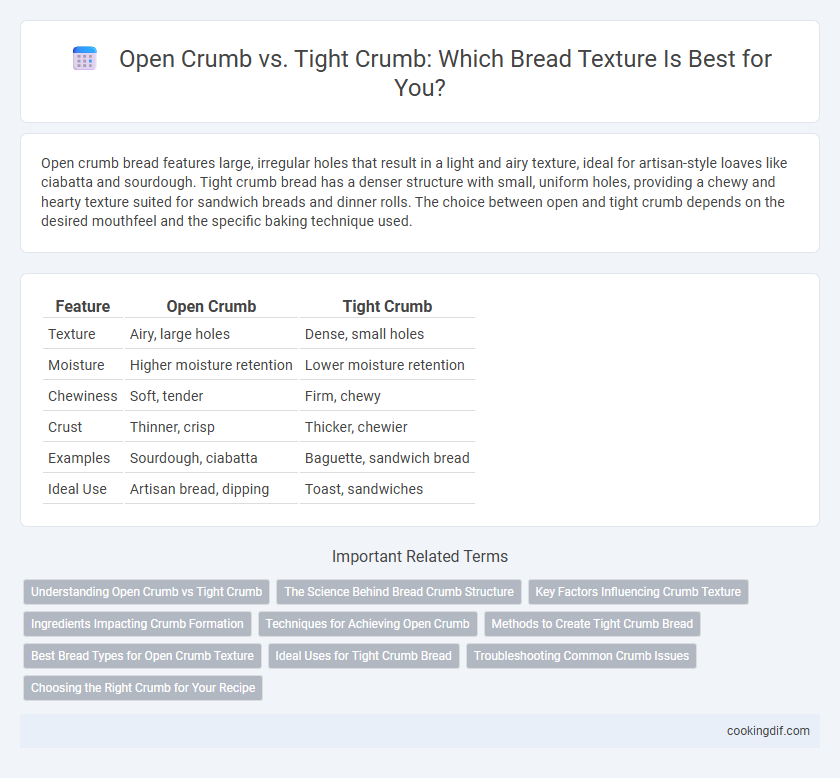Open crumb bread features large, irregular holes that result in a light and airy texture, ideal for artisan-style loaves like ciabatta and sourdough. Tight crumb bread has a denser structure with small, uniform holes, providing a chewy and hearty texture suited for sandwich breads and dinner rolls. The choice between open and tight crumb depends on the desired mouthfeel and the specific baking technique used.
Table of Comparison
| Feature | Open Crumb | Tight Crumb |
|---|---|---|
| Texture | Airy, large holes | Dense, small holes |
| Moisture | Higher moisture retention | Lower moisture retention |
| Chewiness | Soft, tender | Firm, chewy |
| Crust | Thinner, crisp | Thicker, chewier |
| Examples | Sourdough, ciabatta | Baguette, sandwich bread |
| Ideal Use | Artisan bread, dipping | Toast, sandwiches |
Understanding Open Crumb vs Tight Crumb
Open crumb in bread features large, irregular holes due to high hydration and long fermentation, promoting a light, airy texture often found in artisan sourdoughs. Tight crumb exhibits small, uniform air pockets resulting from low hydration and shorter fermentation, yielding a denser, chewier slice typical in sandwich bread and brioche. Understanding these crumb structures helps bakers control moisture, fermentation time, and gluten development to achieve the desired bread texture.
The Science Behind Bread Crumb Structure
The science behind bread crumb structure reveals that open crumb results from high hydration dough and vigorous fermentation, creating large, irregular air pockets through carbon dioxide expansion. Tight crumb forms when dough is denser with lower hydration, less fermentation activity, and stronger gluten networks that trap smaller, uniform gas bubbles. Enzymatic activity, gluten development, and fermentation time critically influence whether bread textures exhibit open or tight crumb characteristics.
Key Factors Influencing Crumb Texture
Open crumb in bread features large, irregular holes caused by high hydration levels and vigorous fermentation, which promote extensive gas retention and gluten development. Tight crumb results from lower hydration, shorter fermentation, and denser dough handling, producing a finer, more uniform crumb structure. Key factors influencing crumb texture include hydration ratio, fermentation duration, flour protein content, and kneading technique.
Ingredients Impacting Crumb Formation
Hydration levels significantly influence crumb texture, with higher water content promoting an open crumb by allowing more steam to expand and create larger air pockets during baking. The type and strength of flour, particularly its gluten content, determine the dough's elasticity and its capacity to trap gas, affecting whether the crumb is tight or open. Yeast activity and fermentation time contribute to gas production and dough structure development, further impacting crumb openness or density.
Techniques for Achieving Open Crumb
Achieving an open crumb in bread requires high hydration dough, typically with water content above 75%, which creates a more extensible gluten network. Incorporating stretch and fold techniques during bulk fermentation enhances gas retention and gluten development without overworking the dough. Using a long, slow fermentation with sourdough or preferments encourages enzyme activity that strengthens the crumb structure and promotes larger air pockets.
Methods to Create Tight Crumb Bread
Achieving a tight crumb in bread typically involves using stronger flour with a higher protein content, which promotes gluten development and results in a denser texture. Precise kneading and shorter fermentation times limit gas expansion, producing smaller, uniform air pockets essential for a tight crumb. Incorporating techniques such as shaping dough more compactly and adjusting hydration levels between 55-65% further supports achieving a firm, evenly textured crumb structure.
Best Bread Types for Open Crumb Texture
Open crumb texture in bread is characterized by large, irregular air pockets commonly found in artisan breads such as ciabatta, baguettes, and focaccia. These bread types achieve an open crumb due to high hydration doughs, long fermentation times, and gentle handling, which promote gluten development and gas retention. Bakers seeking airy, chewy bread with a moist interior often prefer these varieties for their light and open crumb structure.
Ideal Uses for Tight Crumb Bread
Tight crumb bread features a dense, uniform structure ideal for sandwiches and toasting, as it holds fillings and spreads without crumbling. Its fine texture enhances durability, making it suitable for slicing thinly and layering ingredients. This bread type is preferred for recipes requiring sturdy slices, such as club sandwiches or grilled cheese.
Troubleshooting Common Crumb Issues
Open crumb in bread features large, irregular holes, often caused by high hydration dough and adequate fermentation, while tight crumb exhibits a dense, uniform texture resulting from lower hydration and shorter proofing times. Troubleshooting an overly tight crumb involves increasing water content, ensuring proper kneading to develop gluten, and allowing longer fermentation to create gas pockets. Conversely, if the crumb is too open with large holes, reducing hydration, improving dough handling, or adjusting yeast quantity can help achieve a balanced texture.
Choosing the Right Crumb for Your Recipe
Open crumb features large, irregular holes ideal for artisan breads like ciabatta and sourdough, enhancing chewiness and flavor absorption. Tight crumb offers a denser, uniform texture suited for sandwich loaves and enriched breads, providing structure and softness. Selecting the right crumb depends on hydration levels, flour type, and desired bread use, ensuring optimal texture and taste.
Open Crumb vs Tight Crumb for bread texture Infographic

 cookingdif.com
cookingdif.com